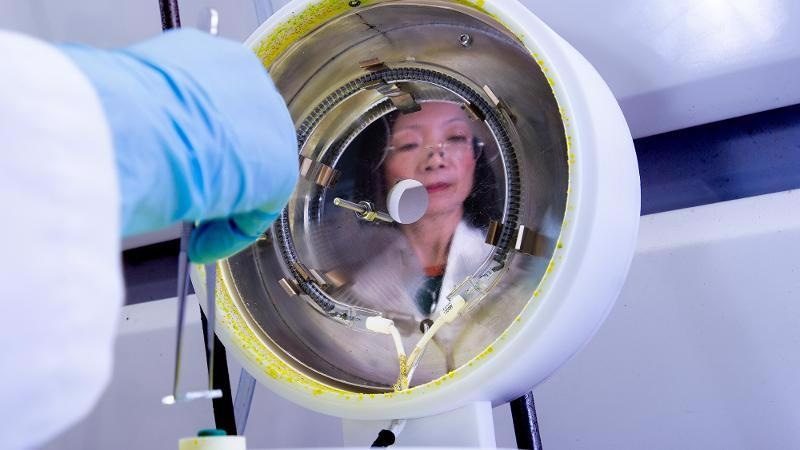Apr 9 2021
Scientists from the Queensland University of Technology (QUT) have used carbon dots to produce a unique kind of 'armor' to enhance the performance of next-generation solar technology.

Image Credit: Queensland University of Technology.
The researchers have designed these carbon dots using human hair waste sourced from a barbershop in Brisbane.
The research team, headed by Professor Hongxia Wang in association with Associate Professor Prashant Sonar from QUT’s Centre for Materials Science, has demonstrated how the carbon nanodots can potentially be used to enhance the performance of perovskite solar cells. The study has been published in the Journal of Materials Chemistry A.
Perovskite solar cells are a comparatively new photovoltaic technology and are regarded as the ideal PV candidate to supply highly efficient, low cost solar electricity in the days to come.
When it comes to power conversion efficiency, perovskite solar cells have demonstrated to be as effective as the existing monocrystalline silicon solar cells available in the market; however, the barriers for scientists focused in this field is to make the technology more stable and cost-effective.
Perovskite solar cells are different from silicon cells and are produced with an easily manufactured compound. And since these solar cells are flexible, they could be utilized in many applications, like backpacks that charge devices on the go, solar-powered clothing and even tents that could act as standalone power sources.
This study is the second major piece of work, thanks to human hair-derived carbon dots as a multifunctional material.
In 2020, Associate Professor Prashant Sonar headed a team of researchers, including Amandeep Singh Pannu, a research fellow from QUT’s Centre for Materials Science, that converted hair scraps into carbon nanodots by splitting the hairs and subsequently burning them at 240°C.
In that research work, the team demonstrated that the carbon dots could be transformed into flexible displays that can potentially be used in upcoming smart devices.
Now, in the latest study, Professor Wang’s research group, which also included Dr Ngoc Duy Pham and Mr Pannu, in association with Professor Prashant Sonar’s research team, applied the carbon nanodots on perovskite solar cells to observe the outcome.
Previously, the research team of Professor Wang had discovered that the performance of a cell could be improved by nanostructured carbon materials.
When Professor Wang’s team added a solution of carbon dots to the perovskite-making process, they found that the carbon dots created a wave-like perovskite layer, wherein the carbon dots surrounded the perovskite crystals.
It creates a kind of protective layer, a kind of armour. It protects the perovskite material from moisture or other environmental factors, which can cause damage to the materials.
Hongxia Wang, Professor, Queensland University of Technology
The new study found that perovskite solar cells coated with the carbon dots had greater stability and a higher power conversion efficiency when compared to perovskite cells lacking the carbon dots.
For around two decades, Professor Wang has been investigating next-generation solar cells and working with perovskite cells ever since they were discovered about 10 years ago, with the main goal of designing stable, cost-effective photovoltaic devices and materials to help address the global energy problem.
Our final target is to make solar electricity cheaper, easier to access, longer-lasting and to make PV devices lightweight because current solar cells are very heavy. The big challenges in the area of perovskite solar cells are solving stability of the device to be able to operate for 20 years or longer and the development of a manufacturing method that is suitable for large-scale production.
Hongxia Wang, Professor, Queensland University of Technology
Professor Wang added, “Currently, all the reported high-performance perovskite solar cells have been made in a controlled environment with extremely low level of moisture and oxygen, with a very small cell area which are practically unfeasible for commercialisation.
To make the technology commercially viable, challenges for fabrication of efficient large area, stable, flexible, perovskite solar panels at low cost needs to be overcome. This can only be achieved through a deep understanding of the material properties in large-scale production and under industrially compatible conditions.
Hongxia Wang, Professor, Queensland University of Technology
In particular, Professor Wang is keen on finding how these perovskite cells could be employed to power spacecraft in the days to come.
Four solar arrays currently power the International Space Station and these arrays can produce up to 120 kW of electricity. However, one major drawback of the present technology in space PVs is the payload weight to get them there.
Although perovskite would be relatively lighter, one of the difficulties for scientists is to design perovskite cells to handle the wide temperature variations—from 185°C to over 150°C—and the extreme radiations in space.
Professor Wang added that the solution could be a decade off, but scientists are continuing to gain a better understanding of this field.
Professor Wang’s research team has now teamed up with Professor Dmitri Golberg from QUT’s Centre for Materials Science to interpret the characteristics of perovskite materials under adverse environmental conditions, like significant temperature variations and powerful irradiation of an electron beam.
“I’m quite optimistic given how much this technology has improved so far,” concluded Professor Wang.
Joining the dots
Video Credit: Queensland University of Technology.
Journal Reference:
Pham, N. D., et al. (2021) Self-assembled carbon dot-wrapped perovskites enable light trapping and defect passivation for efficient and stable perovskite solar cells. Journal of Materials Chemistry A. doi.org/10.1039/D1TA00036E.